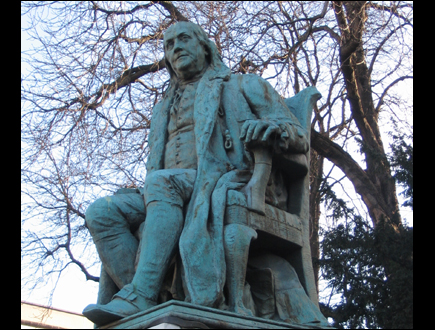
Shortly after the signing of the Declaration of Independence in Philadelphia, Benjamin Franklin accepted a mission from the Continental Congress to seeking an alliance with France and eventually recognition of the independence of the United States of American from the British Empire.
In October 1776, Franklin set off on the 6-week transatlantic crossing to join Silas Deane on the American mission to obtain favor from the Court of France.
Preceded by a diverse and enormous reputation—as man of science, as America’s folksy representative of the Enlightenment, as a needle in the side of the British, as envoy from a people prepared to overthrow a king—Franklin was a celebrity from the moment he set foot on French soil. From 1777 to 1785 he lived in Paris as a veritable superstar in the fields of science, literature, and politics.
Living in a mansion (no longer existing) in the former suburb of Passy, which bordered the Seine in what is now part of the 16th arrondissement, Franklin constantly received guests, both wanted and unwanted, and was spied up by both the French and the British.
In 1776 and 1777, the French were already providing the Americans with covert support (which didn’t always remain covert) in part thanks to the gusto of Caron de Beaumarchais. Beaumarchais, a playwright who’d become famous and controversial for having written The Barber of Seville, funneled supplies to America through the fictitious trading company Roderigue Hortalez & Cie that he operated from a mansion (still existing) in the Marais at 47 rue Vieille-du-Temple.
Deane and Franklin were eventually joined in their mission by Arthur Lee. Though the relationship between the trio was something like the Three Stooges, with Ben in the role of Moe, they worked through diplomatic and less diplomatic circles to convince the French that it was in their interest to support the Americans.
On the heel of good news from Saratoga that reached Europe at the end of 1777, they succeeded in negotiating the Treaties of Amity and Commerce and of Alliance Eventual and Defensive Between His Most Christian Majesty and the Thirteen United States of America. The treaties were signed on Feb. 6, 1778 at the Hotel de Coislin (still existing; Deane was living there at the time) on Place de la Concorde by Conrad Gérard on behalf of King Louis XVI and by Franklin, Deane, and Lee on behalf of the United States of America.
News of the treaty reached the American coast in March 1778. By then Philadelphia, America’s Revolutionary capital, was occupied by the British Army while the then-struggling United States Army gathered their forces at their winter encampment at Valley Forge, 25 miles west. The Treaty of Alliance was ratified by Congress on May 4 and two days later celebrated at Valley Forge in an all-out parade and feu de joie ([gun] fire of joy). The French Alliance is celebrated annually the first weekend in May at Valley Forge National Historical Park.
With France firmly allied with the Americans, Franklin took on the title of Minister Plenipotentiary to the Court of France. His cohorts Deane and Lee were eventually replaced by John Jay and John Adams. (Beaumarchais, meanwhile, his enthusiasm for covert action no longer needed, went and wrote The Marriage of Figaro).
The official treaties ending the Revolutionary War and leaving the Americans freedom to develop their new country were signed by all parties on September 3, 1783. The Treaty of Versailles ended hostilities between France and England (as well as between Spain, an ally of France, and England). That same day Franklin, Jay, and Adams, in the name of the United States of America, and David Hartley, in the name of King George III of England, signed the Treaty of Paris, the definitive peace treaty recognizing independence, thus achieving Franklin’s mission in France. They signed at the Hotel de York on 56 rue Jacob, 6th arrondissement (still existing; Hartley was living there at the time). The treaty was ratified by the U.S. Congress the following year.
In 1785, replaced by Thomas Jefferson, who moved into a mansion (no longer existing) on the Champs-Elysées, Franklin returned home to Philadelphia for the first time in nine years.
He died at the age of 84 on April 17, 1790. When news of his death reached France in June, the National Assembly in France’s first revolutionary year proclaimed three days of mourning.
In honor of the bicentennial of the signing of those treaties, the Daughters of the American Revolution gave Paris the statue shown above. It’s located on Square Yorktown, near Trocadéro, at the end of rue Benjamin Franklin in the 16th arrondissement, near where Franklin had lived. A statue of George Washington on horseback honors Place d’Iéna, 500 yards away along Avenue du Président Wilson.
A reading of Benjamin Franklin’s Last Will and Testament of Benjamin Franklin is one of the best introductions to the life of this American original. Against the backdrop of the distribution of his wealth and possessions, the document tells of the positions he held, his numerous contacts in government and business, the friends and family he owed and felt he owed, his relationships with men and with women, and even his hopes for the young nation he helped birth, all of which can be glimpsed in a single line:
The king of France’s picture, set with four hundred and eight diamonds, I give to my daughter, Sarah Bache, requesting , however, that she would not form any of those diamonds into ornaments either for herself or daughters, and thereby introduce or countenance the expensive, vain, and useless fashion of wearing jewels in this country; and those immediately connected with the picture may be preserved with the same.
Click here for the full text of Franklin’s will.
© 2009, Gary Lee Kraut

